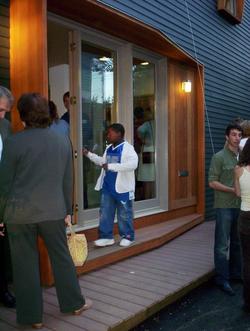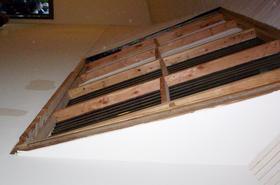 Not only will the sun provide electricity for a new home on Orchard Street. The house will also send unused electricity back to the grid. Welcome to a vision of the energy future.
Not only will the sun provide electricity for a new home on Orchard Street. The house will also send unused electricity back to the grid. Welcome to a vision of the energy future.
Deirdre DeShields’ new house is undoubtedly on the sunny side of the street. On Nov. 1, she’ll be the proud owner of a new state-of-the-art house designed and built by the Yale School of Architecture’s Class of 2006. Situated on the narrow stretch of Orchard between Whalley and Goffe, the 1,500-square-foot house features soaring ceilings, an upstairs loft, attractive landscaping and a 3‑kilowatt photovoltaic system that supplies power through panels mounted on the roof.
The house made its big debut Thursday evening. Although still in its final building stages, with a few tarps and last-minute construction in evidence, the house played host to Yale students and faculty and to the neighborhood, with plenty of fancy food and bottles of wine breaking in the mint-condition kitchen. The atmosphere was celebratory, with guests pouring out onto the Trex deck to celebrate the completion of this year’s student project, traditionally built and designed by Yale’s first-year architecture students.
Brook Denison, a second-year architectural student (the Masters of Architecture program takes three years), was happy with the outcome. He described the “generous space” and gave some insight into the shape of the house, which is traditional with (literally) a few twists. According to Denison, the project was designed with a topographically appropriate fa√ɬßade, meant to fit in with the other structures in the neighborhood. The roof, with its solar panels all but invisible from the ground, is torqued, or twisted slightly, to take advantage of the sun. In addition to an active photovoltaic system, the house also makes use of passive solar features, such as strategically placed windows which also minimize heat gain in the warmer months.
The solar cells have a life expectancy of about 30 years and are supposedly maintenance-free. As an additional feature, if the house produces more energy than it uses, the remainder goes back to the grid, and the homeowner gets a check from the electric company at the end of the year. One of the students will be following up on the energy aspects of the building and looking at its overall energy consumption.

How do five teams of 10 first-year students actually design a house? “The design process is pretty crazy,” concedes Sally Hambright, the student project manager. “There was definitely a lot of give and take,” she said with a laugh indicating gross understatement. The original assignment required students to come up with their own plans, and the designs were judged on their merits, with the “best of” features finding their way into the final project.
Although the assignment didn’t specify a solar power source, the students were inspired to incorporate alternative energy into the scheme. Lindsey Suder, a graduate of the program, negotiated a grant through the Connecticut Clean Energy Fund (CCEF) that provided the entire cost of the $25,000 photovoltaic system. According to Paul Brouard, who’s been the building project director for the past 34 years, “the last seven or eight years, we’ve gone through a number of sustainable phases in these projects.” The houses produced in the previous six years have all earned Energy Star ratings for their fuel efficiency; this year’s house has rated an astounding 94 percent on the EPA’s energy rating system. This kind of success, explained Brouard, is achieved through measures including efficient furnaces, well thought-out building materials and whole-house foam insulation.
Building a house like this isn’t cheap, says Brouard. If you were to start from the ground up, a similar structure would cost about $250,000. When asked about the impact of such a modern structure on the surrounding neighborhood, Brouard was upbeat. “There isn’t any copying of the kind of building, but there certainly is incentive for the neighbors to upgrade their properties and we see it, starting in the landscaping.”

According to Colin Caplan, rehabilitation specialist for the Neighborhood Housing Service (NHS), there’s a definite interest in incorporating solar energy into other neighborhood projects. With the CCEF providing grants to cover half of the solar panel array’s expense, he sees this as a viable option. “It lowers bills, saves the environment and makes consumers think about wasting (natural resources),” although it usually takes about a decade for the system to break even.
Deirdre DeShields, in the meantime, is “beyond excited.” She spent several years on NHS’s Homeownership Center waiting list, not knowing when or where her new home would pop up. She was second in line last year, and this year was her big chance. “Y’know,” she said, “the solar panels — they really explained everything to me.” Her favorite feature is the skylight. She knows it’s still not done, but she says “I use my imagination; it’s gonna be nice.”